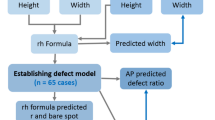Abstract
Objective
The objective of this study was to describe and validate a simple method to quantitatively calculate the missing area of the anterior part of the glenoid in anterior glenohumeral instability.
Materials and methods
The calculations were developed from three-dimensional (3D)-reconstructed computerized tomography en face images of the glenoid with “subtraction” of the humeral head in 13 consecutive cases with known anterior glenohumeral joint instability diagnosed by history and clinical examination. The inferior portion of the glenoid was approximated to a true circle whose center was determined by means of a femoral head gauge. The eroded anterior area was calculated as the ratio between the depth (a perpendicular line from the center of the circle to the eroded edge of the anterior glenoid) and the radius of the inferior glenoid circle. This data was then compared to the results obtained by two additional different methods: direct computerized measurements of the missing area and direct computerized measurement of the ratio between the radius and depth, on two dimensional computed tomography (CT) en face view reconstructions of the glenoid.
Results
We provide a function that correlates the ratio between depth and radius of the inferior glenoid circle and the area of the missing anterior glenoid. The results obtained by three different methods were comparable. Simple trigonometric calculations showed that a 5% area defect corresponds to 0.8 (12.5%) of the radius of the inferior glenoid, while a 20% area defect corresponds to 0.5 (50%) of the same radius (Table 1).
Conclusion
Using this simple method and the function provided, the eroded area of the anterior part of the glenoid in anterior glenohumeral instability can be calculated preoperatively using a 3D CT reconstruction of the glenoid with “subtraction” of the humeral head, obviating the need for sophisticated software to obtain this critical information for preoperative decision making.






Similar content being viewed by others
References
Edwards TB, Boulahia A, Walch G. Radiographic analysis of bone defects in chronic anterior shoulder instability. Arthroscopy 2003; 19: 732–739.
Sugaya H, Moriishi J, Dohi M, Kon Y, Tsuchiya A. Glenoid rim morphology in recurrent anterior glenohumeral instability. J Bone Joint Surg Am 2003; 85-A: 878–884.
Burkhart SS, De Beer JF. Traumatic glenohumeral bone defects and their relationship to failure of arthroscopic Bankart repairs: significance of the inverted-pear glenoid and the humeral engaging Hill-Sachs lesion. Arthroscopy 2000; 16: 677–694.
Boileau P, Villalba M, Héry JY, Balg F, Ahrens P, Neyton L. Risk factors for recurrence of shoulder instability after arthroscopic Bankart repair. J Bone Jnt Surg Am 2006; 88: 1755–1763.
De Wilde LF, Berghs BM, Audenaert E, Sys G, Van Maele GO, Barbaix E. About the variability of the shape of the glenoid cavity. Surg Radiol Anat 2004; 26: 54–59.
Bigliani LU, Newton PM, Steinmann SP, Connor PM, McLlveen SJ. Glenoid rim lesions associated with recurrent anterior dislocation of the shoulder. Am J Sports Med 1998; 26: 41–45.
Stevens KJ, Preston BJ, Wallace WA, Kerslake RW. CT imaging and three-dimensional reconstructions of shoulders with anterior glenohumeral instability. Clin Orthop 1999; 12: 326–336.
Itoi E, Lee SB, Berglund LJ, Berge LL, An KN. The effect of a glenoid defect on anteroinferior stability of the shoulder after Bankart repair: a cadaveric study. J Bone Jnt Surg Am 2000; 82: 35–46.
Lo IK, Parten PM, Burkhart SS. The inverted pear glenoid: an indicator of significant glenoid bone loss. Arthroscopy 2004; 20: 169–174.
Gerber C, Nyffeler RW. Classification of glenohumeral joint instability. Clin Orthop Relat Res 2002; 1: 65–76.
Saito H, Itoi E, Sugaya H, Minagawa H, Yamamoto N, Tuoheti Y. Location of the glenoid defect in shoulders with recurrent anterior dislocation. Am J Sports Med, 2005; 33(8): 889–893.
Huijsmans PE, Haen PS, Kidd M, Dhert WJ, van der Hulst VPM, Willems WJ. Quantification of a glenoid defect with three-dimensional computed tomography and magnetic resonance imaging: a cadaveric study. J Shoulder Elbow Surg 2007; 16: 803–809.
Spiegel MR. Mathematical handbook of formulas and tables. Schaum’s Outline Series, 1968.
Acknowledgment
The authors would like to acknowledge the advice received from Radel Ben-Av, PhD on mathematical issues. No grants have been received.
Author information
Authors and Affiliations
Corresponding author
Mathematical formulation
Mathematical formulation
As the inferior part of the glenoid is circular and the leading edge of the remodeled glenoid area is linear, it is possible to calculate the relationship between the missing anterior glenoid area (s1) and the ratio between the radius of the circle (R) and the distance from the center of the circle to the leading edge of the missing area (d) (depth of the defect) as follows:

Using simple geometrical formulas [13] the area s1 (missing area) is
where α is the angle shown in the figure, 0 ≤ α ≤ π.
The depth d as a function of the circle radius and the angle is:
The ratio q between the affected area s1 and the total area of the circle is
One can see that when d is 0.8 of the radius, q = 5%. In other words, when the depth of the defect is 0.8 of the radius of the inferior glenoid circle the missing area is 5%.
Analogously, when d is 0.5 of the radius, q = 20%.
Rights and permissions
About this article
Cite this article
Barchilon, V.S., Kotz, E., Barchilon Ben-Av, M. et al. A simple method for quantitative evaluation of the missing area of the anterior glenoid in anterior instability of the glenohumeral joint. Skeletal Radiol 37, 731–736 (2008). https://doi.org/10.1007/s00256-008-0506-8
Received:
Accepted:
Published:
Issue Date:
DOI: https://doi.org/10.1007/s00256-008-0506-8




